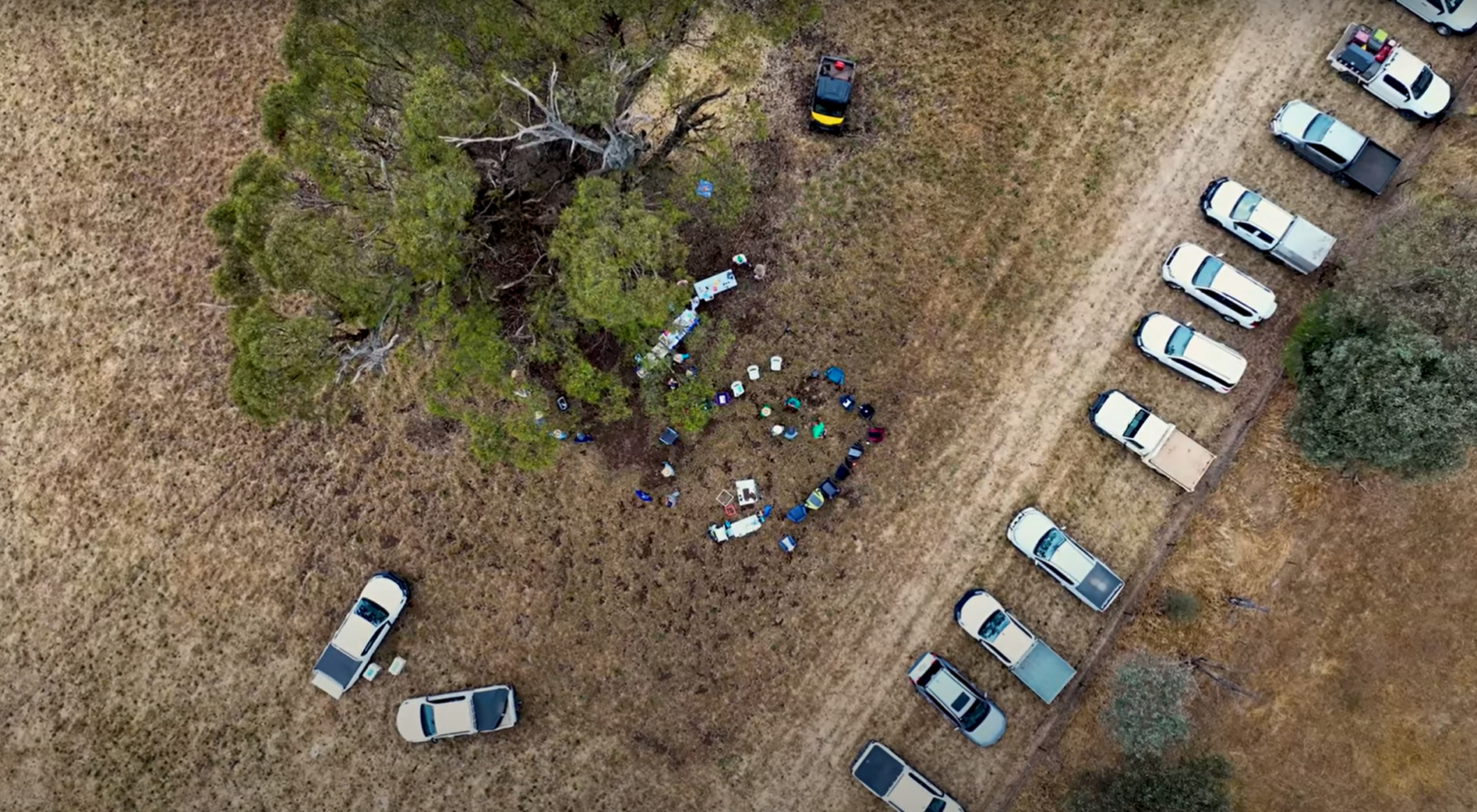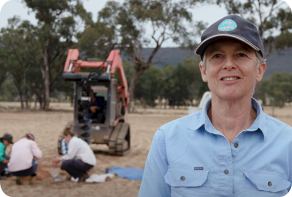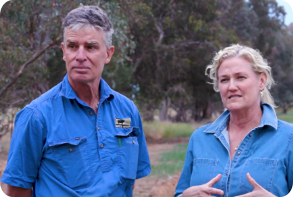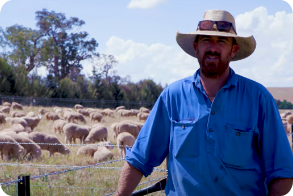Coming together for resilient soils and landscapes in the Riverina
Part of the Riverina LLS Drought Resilience and Soil Monitoring Series | Published July 2024
The Riverina Drought Resilient Soils and Landscapes project supported 15 farmers across four regions of the Riverina – Murrumbidgee, Upper and Lower Slopes, and Lachlan – to implement one of three drought-resilience practices (enhanced farm dams, native shelterbelts or stock management areas) and to set up and conduct soil and landscape monitoring, including in-field assessments and soil lab testing (see Image 1 for soil sampling at one farm). Led by the Riverina Local Land Services (LLS), in partnership with Soils for Life and ANU Sustainable Farms, the project was developed to improve drought resilience and build soil literacy for the group of Riverina farmers.
To help enhance learning and build supportive farmer networks, the core practice and soil monitoring activities were supported by a number of farmer-to-farmer learning opportunities, including:
- Field days
- Online farmer discussion group
- Quarterly webinars
- WhatsApp group

Image 1. Soil sampling at Highfield Farm and Woodland. Source: Soils for Life.
Meet the Riverina Farmers
Seven of the 15 farmers shared their experiences for this group case study. Each farmer implemented drought resilient activities relevant to their farming context, each of which is geographically dispersed around the Riverina (see Figure 1 for the location of each farm).
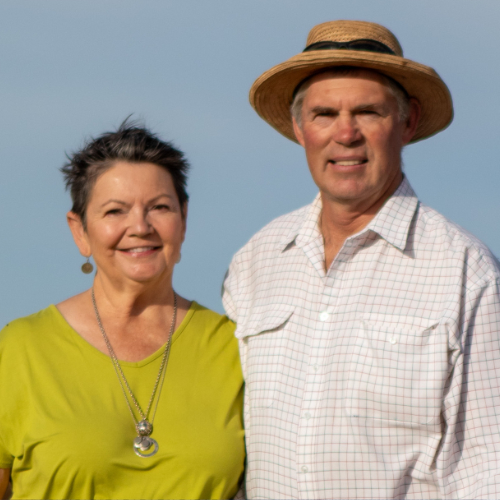
Bert and Liz Matthews at Bedarbidgal
Riverina Region
Murrumbidgee
Enterprise
Dryland grazing Merino sheep and Angus cattle
Drought resilience practice
Paddock tree regeneration with tree guards
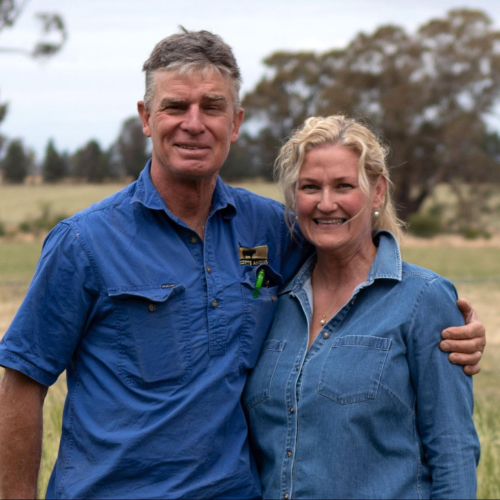
Cindy and Steven Scott at Glen Elgin
Riverina Region
Lower Slopes
Enterprise
Seedstock, cattle breeding, commercial Angus beef production and wheat and canola cropping
Drought resilience practice
Shelterbelts
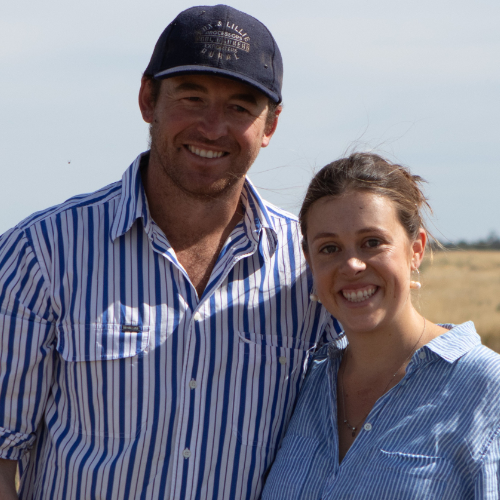
Jack and Annabell Hanna
Riverina Region
Murrumbidgee
Enterprise
Dryland Merino sheep grazing, with seasonal cattle production and agistment, typically during and after a flood from the Lachlan River
Drought resilience practice
Stock management area
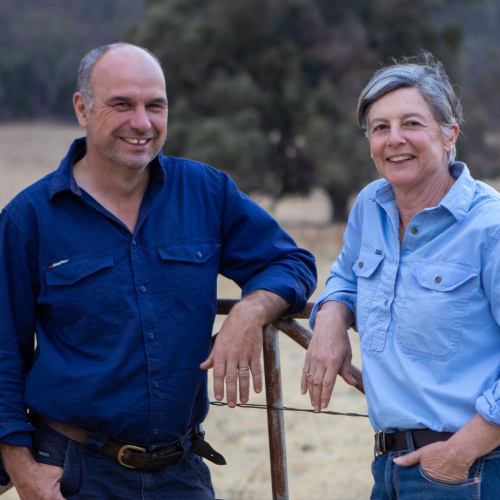
Craig and Dee Wilkes-Bowes at Anderloose
Riverina Region
Lachlan
Enterprise
Grazing sheep and cattle, fodder crops and occasional commercial cropping
Drought resilience practice
Stock management area
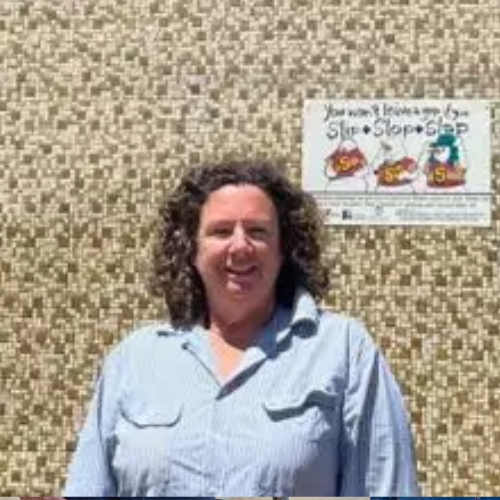
Di Kelly-Chirgwin at Farm 643
Riverina Region
Murrumbidgee
Enterprise
Mixed grazing
Drought resilience practice
Farm dam enhancement
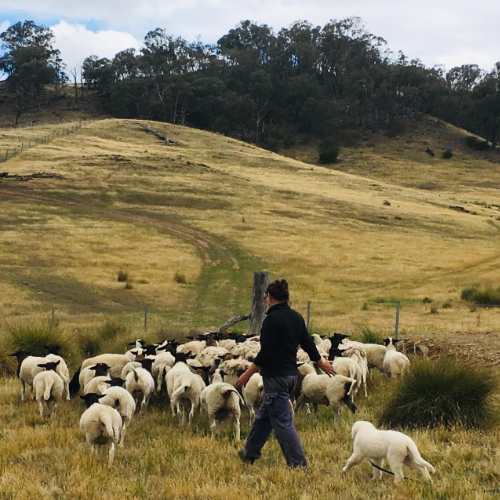
Louise Freckleton at Highfield Farm and Woodland
Riverina Region
Upper Slopes
Enterprise
Small-scale direct to customer Dorper lamb, Dexter beef, pasture-raised eggs and chicken
Drought resilience practice
Farm dam enhancement

Peter O’Connell at Stormy Lodge
Riverina Region
Lower Slopes
Enterprise
Mixed cropping and sheep production
Drought resilience practice
Stock management area
Riverina Landscapes and Soils
The Riverina region sits mostly on Wiradjuri Country in south-western New South Wales. It is one of Australia’s most productive and diverse agricultural regions. Covering approximately 115,000 sq km, the climate and landscapes vary greatly; from the steep alpine slopes of the Snowy Mountains to the dry, inland plains of the rangelands around Hay and Carrathool.
The region occupies a large section of the Murray–Darling Basin, and is defined by the Murray and Murrumbidgee Rivers. Water management is crucial for the landscape, with irrigated farmland constituting 5% of the region’s area. The Riverina region supports predominantly dryland grazing and cereal-based cropping – which together account for 80% of land use – and also supports other diverse enterprise types such as fruit and nut orchards, vineyards and cotton. In addition to being an agriculturally productive area, the region also supports many national parks and reserves, as well as the Ramsar-listed site Fivebough and Tuckerbil Wetlands.1
There are six unique landscapes in the Riverina LLS region: Rangelands, Irrigation Areas, Riverina Plains, Murrumbidgee, South West Slopes and South West Highlands. The participating farmers are spread across these different landscapes (see Figure 1).

Figure 1. A map of the Riverina region showing the seven participants’ properties. Source: Soils for Life.
Building Drought Resilience on Farm
Three practices
Each farmer chose one of three drought resilience practices: stock management area (SMA), enhanced farm dams or shelterbelt, and received practical guidance and financial support from the Riverina LLS.2
Stock management areas
As purpose built pieces of infrastructure, SMAs can make feeding, watering and monitoring stock health more efficient, ease the process of destocking and offer a fast way to get stock off pasture. This practice allows retention of groundcover, which prevents soil erosion from wind and rain, and supports the preservation and faster recovery of pastures and landscapes across the farm.
Watch Anthony Nicholls explain why and how he built an SMA at Tumulla.
Read about why and how the Wilkes-Bowes and the Hannas implemented their SMA.
Farm dam enhancements
Revegetation in and around a dam is the key to good management. Healthy, well-vegetated dams provide habitats for a host of animals, which in turn help improve the function of the dam by cycling nutrients from the dam into the wider landscape, and by modulating sediment, nutrient salt and algal levels within the dam. Farm dam enhancements generally involve excluding stock with fencing infrastructure to enable vegetation to regrow. Stock exclusion has the added benefit of preventing pugging, bank erosion and water pollution, all of which can degrade the dam’s water quality.
Watch Dee and Craig Wilkes-Bowes and Anthony Nicholls explain why and how they built their dam enhancements.
Shelterbelts
Whether as part of shelterbelts or standing individually in a paddock, trees serve as vital tools for livestock protection, erosion mitigation and wind-speed reduction across pastures. Their significance extends beyond these functional aspects, as native trees play a crucial role in supporting diverse wildlife populations and aiding natural pest control on the farm.
Watch the Matthews and the Scotts explain why and how they are growing and protecting trees on their property, through the implementation of shelterbelts and tree guards.
Read our case studies on the Matthews and the Scotts
2To read more about these practices, explore our project partner resources Riverina LLS free training. For information on SMAs see a recent publication produced by MLA. For more information on dam enhancements and shelterbelts see ANU Sustainable Farms.
Developing soil monitoring routines
With support from Riverina LLS and Soils for Life, the farmers have been monitoring the health of their soils through their own observations and in-field assessments, complemented by soil sampling and lab testing. Each farmer participating in the project received a report offering a general interpretation of their soil test results and had the opportunity to discuss their results with a Soils for Life soil scientist. They were also encouraged to share their photos and insights of their in-field observations and assessments with each other via the online farmer discussion group, Whatsapp group and field days.
In-field assessments
Farmers were encouraged to do four rounds of monitoring in August 2023, November 2023, February 2024 and May 2024. Each time, they applied the following monitoring techniques: photopoints, groundcover, soil infiltration, aggregate stability, soil organisms and soil pH assessment using guides provided by Soils for Life.
The in-field assessments have been developed into a ‘Soil Health Challenge’, see the Soil Health Assessment Guide below/appendix (with the exception of the pH assessment3).
3Farmers used a Manutec Soil pH Test Kit, which comes with easy to follow instructions. The kit is based on Raupach and Tucker’s field method for assessing soil pH. See Raupach, M and Tucker, B (1959) The field determination of soil reaction. Journal of the Australian Institute of Agriculture Science 25:129−133. To see a soil pH demonstration, visit: https://www.youtube.com/watch?v=HZz3-cv_GGc&t=123s

Image 2. Steven Scott doing one of his regular in-field assessments. Source: Grow Love Projects.
To supplement the in-field assessments, each farmer collected soil samples from one location for laboratory analysis. The samples were collected from four different depths in the soil (see Image 4) and submitted to the laboratory for a range of soil physical, chemical and biological tests. The purpose of sampling at a single location was to provide the farmers with a more in-depth account of the soil at their monitoring site so they can track changes in these soil over time. With additional investment, soil monitoring and sampling at multiple locations across a property would provide the farmers with a broader understanding of their soils.
The monitoring information generated by the landholders also fed into the field days and became a feature of the ‘farmer-to-farmer’ learning experiences described below.

Image 3. Collecting soils at the ‘Kyeema’ soil monitoring site at Bedarbidgal. Source: Riverina LLS.

Image 4. Soil at different depths at the ‘Kyeema’ site at Bedarbidgal. Source: Riverina LLS.
Farmer-to-farmer learning
Farmers had the opportunity to participate in several activities (field days, webinars, an online discussion group and a WhatsApp group) with the goal of building a community of farmers supporting each other in implementing their projects and soil and landscape monitoring.
The online farmer discussion group ran for 90 minutes each month over the course of a year and provided a mix of presentations and free discussion. These sessions created a shared learning environment where participants could introduce ideas, ask questions of the project partners and the group and receive feedback on what they were noticing about their drought resilience practices and soil and landscape monitoring. The online sessions included quarterly webinar presentations by LLS, Soils for Life and ANU staff. The WhatsApp group allowed the farmers and project team to ‘keep the conversation going’ in between meetings and to ask questions or share experiences as they arose. Field days offered an opportunity for some of the 15 farmers to open their gates to others in the group as well as to neighbours and curious farmers in the region (see Table 1).
Table 1. A snapshot of program elements over two years.
| Month | Activities | Description | Project partner |
| 2023 | |||
| April | Field Day 1 | Kolonga, Harefield | LLS/SFL/ANU |
| June | Discussion Group | Welcome and onboarding | SFL |
| June | Field Day 2 | Bedarbidgal, Hay (Case Study Farm) | LLS/SFL |
| July | Webinar | Soil monitoring methods | SFL |
| August | Webinar | Dams | ANU |
| September | Discussion Group | Open Discussion – Share monitoring results | SFL |
| October | Webinar | Soil monitoring methods | SFL |
| November | Webinar | Shelterbelts | ANU |
| November | Field Day 3 | Tumulla, Coolac (Case Study Farm) | LLS/SFL |
| December | Discussion Group | Open Discussion – Australian Feedbase Monitor Tool and Share monitoring results | Cibo Labs / SFL |
| 2024 | |||
| February | Webinar | SMA | LLS |
| March | Discussion Group | Share monitoring results | SFL |
| March | Field Day 4 | Wooroola, Maxwell | LLS/SFL/ANU |
| March | Field Day 5 | Anderloose, Naradhan (Case Study Farm) | LLS/SFL |
| April | Webinar | How to read a soil lab test report | SFL |
| May | Discussion Group | Questions about your soil lab tests | SFL |
| June | Discussion Group | Wrap up, reflections and close | SFL/LLS |
Insights and Reflections
Being proactive for dry times
Making changes to infrastructure and farm management when the season is good rather than waiting for a crisis to act was a positive outcome for many of the farmers and helped build their confidence to face future dry times. For example, Bert Matthews put in tree guards after a wet season when a lot of young trees came up and needed protection. And the Hannas built their SMA when pasture was abundant, so it meant they had no pressure to use the SMA immediately.
‘We shouldn’t waste that opportunity and if we had not gone around and started to guard them, well, then the stock would have taken them back and like the next dry time we wouldn’t know they were even there.’ – Bert Matthews
For many of the farmers, the funding for implementing a drought resilient practice was very welcome. The funding helped their long-term goals of building drought resilience, supported the implementation of new drought resilience infrastructure in the near-term, provided accountability in reaching goals and provided support through hands-on guidance from experts. The infrastructure was supported by a $10k grant from Riverina LLS, funded by the Australian Government’s Future Drought Fund, and while in most cases additional co-investment from the farmers was required, most farmers said that having the funding put the project to the top of the list of priorities and meant that there was accountability to follow through.
Building and refining knowledge for farm resilience
Overall, the farmers reported increased levels of new knowledge. All eight farmers in an end of project survey felt that their learnings from the project have led to their farm being more resilient to manage dry times. Many farmers commented on their increased or refined knowledge of their own soils and of soil monitoring methods. Six out of eight farmers felt better equipped and two felt somewhat better equipped to undertake soil monitoring as a result of the online learning and WhatsApp group. Participating in the Riverina project has led Steven Scott to reflect on ‘how little value he had been getting out of lab results in the past’, and ‘how little he really understood about what the soil test results mean’. He found it ‘incredibly valuable to have expert consultation’ in interpreting the soil test results and relating the results to practical implications in the context of his farming enterprises.
Combining practice implementation with monitoring soil health was viewed as having great value within the program for many participants. Bert Matthews believes his own knowledge of soil health has increased and his monitoring habits have improved. The farmer-led soil assessments gave him greater confidence and helped prepare him to recognise changes in soil health. He believes he can use this information in a more preemptive way to make management decisions. Some farmers commented on the benefit of ongoing, informal communication of the soil monitoring experience within the group, which allowed stories, insights and challenges to be shared along the way.
As a result of the learning, many farmers plan to expand their soil monitoring programs. For example, the process helped the Hannas see the value of monitoring more than one site to capture the variability across the landscape. They now plan to extend their monitoring to other sites across their property to better understand how their range of soils respond to changes in land use and management.
Types of information
Expert knowledge was appreciated by many but some farmers wanted more time with specialists than was available within the scope of the project. For the Hannas, the expert advice from LLS representatives was invaluable in getting started. Bert Matthews also found LLS very supportive in advising on optimal locations for installing tree guards based on site conditions and goals. The Scotts found the discussion groups most useful when there were expert presentations. At least one farmer was seeking more technical, information-rich content across the activities and would consider participating in future groups if they had a technical focus on detailed management practices that could improve soil health and productivity specifically in cropping enterprises. Another farmer felt there was an overemphasis on soil at the expense of a more holistic ecological approach.
Value of having a mix of activities
Many of the farmers enjoyed the mix of different formats for learning and skills development and having expertise close on hand, including soil scientists, agronomists and agricultural specialists, to ask detailed questions and dive into specifics off the cuff.
For the Wilkes-Bowes, the combination of webinars, online discussion group sessions, WhatsApp, farm visits and field days worked well, with the field days providing practical feedback and the smaller online sessions becoming more focused towards the end of the series when fewer people could attend.
Steven Scott observed the quality of engagement in the online sessions was genuine and those who committed really gave each other support. And for the Hannas, the field days were the most useful because they were able to see solutions in the actual environment with their own eyes.
The Hannas really enjoyed the WhatsApp group because they could see images and comments that were happening in real-time (see Images 5 and 6). The WhatsApp also offered an opportunity for both targeted discussions to take place and for organic connections to form within the group. And the platform was also a useful place for sharing resources and for reminding the group about upcoming events. Steven had a lot of positive feedback on the WhatsApp coordination and supplementary content provided to support those who missed in-person events.

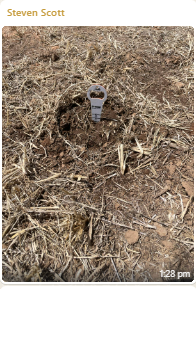
Image 5. Steven Scott’s infiltration assessment images showing infiltration rates and comments in the WhatsApp group. Source: The Scotts.

Image 6. Jack Hanna discusses groundcover observations within the WhatsApp group. Source: the Hannas.
Working across different farming contexts
Many of the farmers valued learning about drought resilience with other farmers in the group who shared similar contexts (e.g. region), but given the diverse landscapes within the Riverina, sometimes found it hard to relate to the other contexts. Yet, many also saw value in the diversity of experiences and contexts and connecting with others across different stages of career or practice change.
Reflecting on their participation in the project, the Wilkes-Bowes found that learning from people in similar rainfall areas was most valuable, though hearing different approaches from different regions provided additional perspectives. They also found relief and greater confidence approaching drought knowing that there are others in similar situations.
It’s good to hear what people are doing in other places. I probably learned most from people who are in a similar area … on one hand if everyone had been within a 200 km radius of us that might have been more relevant. But it’s also good to hear what people are doing in slightly different systems and landscapes. You just have to remember to put outcomes in context of rainfall! – Dee Wilkes-Bowes
The Hannas had a similar experience. Overall the experience has revealed to them a lot of new information and, while certain topics weren’t especially relevant to their farming context, they can see the advantages of participating in broad-focused groups.
Cindy and Steven Scott valued the online sessions as an opportunity to ask questions and hear different perspectives. Steven highlighted the diversity of ideas presented and noted that he always tried to keep his Tuesday morning free.
‘Everyone came from their different background with their different thoughts and tossed those ideas in.’ – Steven Scott
A ‘safe space’ to share knowledge, ‘failures’ and stage of practice change
Many of the farmers appreciated having a safe space within the group discussions to share ‘failures’ as well as successes. Overall many farmers appreciated being met where they were at in terms of their existing soil knowledge and being supported to build on and refine existing knowledge.
It was helpful for farmers to know that they weren’t alone, especially when trying out new practices and monitoring techniques. For example, quite a few of the farmers experienced compaction issues at their monitoring sites. As Bert recalls:
‘A number of us couldn’t get our shovels into the soil for a start. So that’s interesting and tells a story of what’s happening … and the compaction that’s in the soil … and how quickly or how little infiltration there is in the soil.’ – Bert Matthews
The Matthews believe their knowledge of soil health has increased and their monitoring habits have improved as a result of the variety of farmer-to-farmer engagements and facilitated learning sessions. Undertaking the soil monitoring within a shared learning environment has given the Matthews greater confidence and helped them to recognise changes in soil health. Bert Matthews found value in farmer-to-farmer peer learning through the exchanges of ideas and insights on revegetation practices.

Image 7. Bert Matthews sharing his observations from soil monitoring in the Riverina WhatsApp group. Source: Bert Matthews.
For the Wilkes-Bowes, the program helped focus and refine their approaches to drought resilience rather than fundamentally changing their understanding. The financial assistance through the program also enabled them to complete their important drought resilience goals and focus on the infrastructure they know they need.
Attendance and putting aside time
For many, putting time aside for multiple activities, including joining the online sessions or doing the in-field assessments, was a challenge. Many farmers couldn’t make it to the field days, and for some the ongoing expectation of monitoring and contributing was too much given their other commitments.
Most of the 15 farmers joined the online discussion group, except in the case where the timing clashed with other farm commitments. Finding a time that worked for everyone was a challenge for project staff, which was disappointing for at least one farmer. And while attendance at the start was pretty strong at just under 100%, it petered out towards the end of the project. Some found the smaller numbers useful to focus the sessions but for some of the regulars, the lack of overall attendance was a disappointment. And while there was acknowledgement that those not attending had good reason, some felt it affected the overall cohesion of the group. One suggestion was to have an in-person event at the beginning of the program to help people to establish relationships and build trust within the group.
Future steps
There was strong overall enthusiasm from four of the seven farmers in this case study to maintain an ongoing version of the group following the end of the project. One farmer would first like to know what would be the focus and expected benefits of a future group, suggesting that now the group has introductory knowledge, there could be an opportunity to break up into more specialised areas. While one farming family found some topics weren’t very relevant to their environment, they were still open to a variety of information and they could see the benefits of a broad group. Rather than continuing in a group, another farming family would like ongoing access to expertise from program facilitators as this would be beneficial, even if just ad hoc or through annual check-ins. And another farmer would like to see a version of the group continue, with a particular focus on supporting and facilitating those who are committed to doing the work.
Videos about this project
Watch the Hannas and other Riverina farmers talk about the Riverina project, soil monitoring and three drought resilient practices.
Soil Monitoring in the Riverina
Native Shelterbelts in the Riverina
Stock Management Areas in the Riverina
Dam Enhancements in the Riverina
Downloads and links
See the links below to download documents relevant to this page
Acknowledgements
This case study is part of the Riverina Drought Resilient Soils and Landscapes project, which aims to support producers in adopting drought resilient practices and enhance their landscape and soil monitoring capabilities. The project is supporting 15 producers to adopt one of three well-established management practices that enhance agricultural productivity and profitability during or after droughts while safeguarding natural resources. The project also involves the farmers participating in soil monitoring activities, field days, an online farmer discussion group and a WhatsApp group. As part of the project, Soils for Life produced a series of case studies following farmers as they implement a practice and set up soil monitoring. This group case study presents the range of project activities, explores the benefits of farmer discussion groups and the experiences of seven of the producers. This project is led by Riverina Local Land Services, in conjunction with ANU Sustainable Farms and Soils for Life. This project has received funding from the Australian Government’s Future Drought Fund. We acknowledge that the contents of this document do not necessarily reflect the views of these contributors.

This project has received funding from the Australian Government’s Future Drought Fund.
For more information
Follow us for the latest
If you have any questions, get in touch at [email protected].




